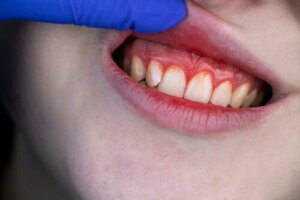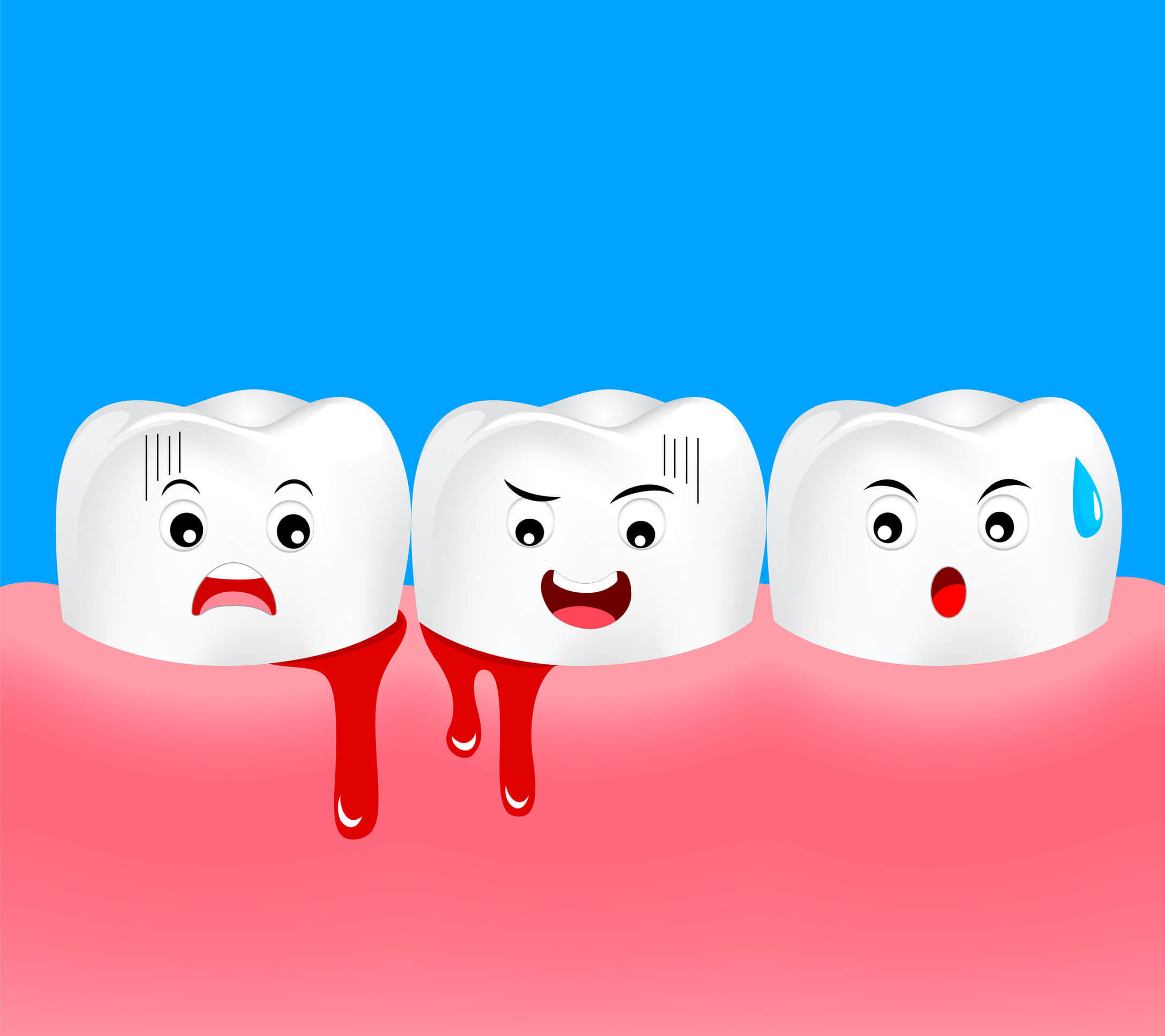What to Do if Your Child's Gums Bleed

If during tooth brushing you notice that your child’s gums bleed, you shouldn’t overlook the situation. Many times, bleeding gum tissue is normalized as part of dental hygiene, but you should pay attention to it and look for a solution.
If you want to know why your child’s gums bleed and what you should do about it, keep reading.
Why do my child’s gums bleed?
Bleeding gum tissue is one of the most characteristic symptoms of gum inflammation. This condition is known as gingivitis, and although it’s more common in adults, it can also occur in children.
In general, gingivitis in children is associated with inadequate or insufficient dental hygiene. For example, when all tooth surfaces and gums aren’t brushed properly.
This causes food debris and bacteria in the mouth to accumulate and form a sticky film on the oral surfaces: Bacterial plaque. Over time, minerals in the mouth eventually build up on this layer and turn it into tartar.
All these elements that adhere to the teeth irritate the gingival tissue and inflame it, and this phenomenon is manifested through swelling, deformation, and predisposition to bleeding gums. In addition, the child usually manifests other conditions, such as bad breath and dental sensitivity or pain.
Dental bleeding usually appears during brushing, although in more advanced cases, it’s triggered by the slightest friction.
If gingivitis isn’t treated in a timely manner, it evolves into other more serious conditions, such as periodontitis, which is the compromise of the deep tissues of the mouth.
For this reason, if you discover that your child’s gums are bleeding, you must act promptly to put an end to the problem.

What to do if my child’s gums bleed?
As soon as you notice that your child’s gums bleed, take these actions immediately.
1. Visit a pediatric dentist
When you notice that your child’s gums bleed during tooth brushing, it’s best to schedule an appointment with their pediatric dentist. Seeing the dentist promptly will help to get an accurate diagnosis of the situation and treat the problem before it becomes more complicated.
Treatment of gingivitis consists of eliminating bacterial plaque. By removing the cause of the inflammation, the gums can regain their health.
Many times, the professional only has to advise adults on how to best care for their children’s mouths. Clarifying which toothbrush and toothpaste to use and how to perform the cleaning movements (brushing and flossing) is essential in order to control bacterial plaque. In addition, the professional may recommend the use of a home mouthwash to optimize hygiene.
The use of bacterial plaque disclosers is useful to visualize the accumulations of plaque that need to be removed. This way, both children and their parents can improve their cleaning techniques.
At other times, professional cleaning is necessary, especially in cases of tartar build-up. This is a simple treatment, through which the dentist removes calculus and plaque deposits with rotary instruments and special pastes.
Remember that although it seems like everything’s going well in your child’s mouth, it’s best to visit the dentist for a check-up every 6 months. Periodic check-ups are essential to detect any problem in time and provide a timely solution.
2. Extreme tooth brushing
As we told you, when your child’s gums bleed, the solution is to eliminate the bacterial plaque that causes the problem. This can be done if oral hygiene is optimized.
Since we’re talking about children, parents should be in charge of brushing their teeth to be able to reach all the sides of all the teeth in the mouth.
Special attention should be paid to cleaning the area where the tooth meets the gingival tissue. Then, circular and sweeping movements should be combined, in the direction from the gum towards the dental crown.
They should be gentle so as not to cause discomfort, but with enough pressure to remove bacterial plaque. In addition, oral hygiene includes cleaning the tongue.
The duration of brushing should be approximately two minutes. It should be done at least three times a day or after every meal.
The toothbrush and toothpaste are very important elements and should meet the following requirements:
- A small head, sized according to the infant’s mouth.
- Soft bristles.
- Toothpaste with fluoride in the appropriate doses, according to the child’s age.
3. Use dental floss
To remove the bacterial plaque that accumulates in the interdental spaces, you need to use dental floss, as the bristles of the toothbrush don’t reach these areas during cleaning.
Parents should floss with back and forth movements in each space and then use a sweeping motion. First, pressure is applied against one of the dental walls and then the action is repeated in the same space, against the other dental wall.
The process is repeated throughout the mouth, to clean all the proximal faces of the dental elements.
There are some accessories that can facilitate the interdental cleaning of the mouth of children. For example, thread holders, interdental brushes, or oral irrigators for cleaning these difficult areas.
4. Use mouthwash

The use of mouthwashes should be limited to cases where the child has mastered the ability to spit. You should explain that the liquid placed in the mouth shouldn’t be swallowed, but is for rinsing the teeth and must be discarded.
In some cases, rinsing with warm salt water can reduce gingival inflammation and relieve the symptoms of gingivitis.
Finally, certain dental rinses are useful to reduce the proliferation of bacteria in the mouth. However, their use in children should only be limited to specific cases in which the dentist prescribes them. Their application should follow the precise indications of the professional to avoid undesired consequences.
Bleeding gums can be prevented
You can prevent your child’s gums from becoming inflamed and bleeding with a simple measure: Good oral health care from infancy.
Inculcating dental hygiene habits, such as brushing and flossing, together with a healthy diet and regular visits to the dentist are key factors in order to take good care of your child’s mouth.
If during tooth brushing you notice that your child’s gums bleed, you shouldn’t overlook the situation. Many times, bleeding gum tissue is normalized as part of dental hygiene, but you should pay attention to it and look for a solution.
If you want to know why your child’s gums bleed and what you should do about it, keep reading.
Why do my child’s gums bleed?
Bleeding gum tissue is one of the most characteristic symptoms of gum inflammation. This condition is known as gingivitis, and although it’s more common in adults, it can also occur in children.
In general, gingivitis in children is associated with inadequate or insufficient dental hygiene. For example, when all tooth surfaces and gums aren’t brushed properly.
This causes food debris and bacteria in the mouth to accumulate and form a sticky film on the oral surfaces: Bacterial plaque. Over time, minerals in the mouth eventually build up on this layer and turn it into tartar.
All these elements that adhere to the teeth irritate the gingival tissue and inflame it, and this phenomenon is manifested through swelling, deformation, and predisposition to bleeding gums. In addition, the child usually manifests other conditions, such as bad breath and dental sensitivity or pain.
Dental bleeding usually appears during brushing, although in more advanced cases, it’s triggered by the slightest friction.
If gingivitis isn’t treated in a timely manner, it evolves into other more serious conditions, such as periodontitis, which is the compromise of the deep tissues of the mouth.
For this reason, if you discover that your child’s gums are bleeding, you must act promptly to put an end to the problem.

What to do if my child’s gums bleed?
As soon as you notice that your child’s gums bleed, take these actions immediately.
1. Visit a pediatric dentist
When you notice that your child’s gums bleed during tooth brushing, it’s best to schedule an appointment with their pediatric dentist. Seeing the dentist promptly will help to get an accurate diagnosis of the situation and treat the problem before it becomes more complicated.
Treatment of gingivitis consists of eliminating bacterial plaque. By removing the cause of the inflammation, the gums can regain their health.
Many times, the professional only has to advise adults on how to best care for their children’s mouths. Clarifying which toothbrush and toothpaste to use and how to perform the cleaning movements (brushing and flossing) is essential in order to control bacterial plaque. In addition, the professional may recommend the use of a home mouthwash to optimize hygiene.
The use of bacterial plaque disclosers is useful to visualize the accumulations of plaque that need to be removed. This way, both children and their parents can improve their cleaning techniques.
At other times, professional cleaning is necessary, especially in cases of tartar build-up. This is a simple treatment, through which the dentist removes calculus and plaque deposits with rotary instruments and special pastes.
Remember that although it seems like everything’s going well in your child’s mouth, it’s best to visit the dentist for a check-up every 6 months. Periodic check-ups are essential to detect any problem in time and provide a timely solution.
2. Extreme tooth brushing
As we told you, when your child’s gums bleed, the solution is to eliminate the bacterial plaque that causes the problem. This can be done if oral hygiene is optimized.
Since we’re talking about children, parents should be in charge of brushing their teeth to be able to reach all the sides of all the teeth in the mouth.
Special attention should be paid to cleaning the area where the tooth meets the gingival tissue. Then, circular and sweeping movements should be combined, in the direction from the gum towards the dental crown.
They should be gentle so as not to cause discomfort, but with enough pressure to remove bacterial plaque. In addition, oral hygiene includes cleaning the tongue.
The duration of brushing should be approximately two minutes. It should be done at least three times a day or after every meal.
The toothbrush and toothpaste are very important elements and should meet the following requirements:
- A small head, sized according to the infant’s mouth.
- Soft bristles.
- Toothpaste with fluoride in the appropriate doses, according to the child’s age.
3. Use dental floss
To remove the bacterial plaque that accumulates in the interdental spaces, you need to use dental floss, as the bristles of the toothbrush don’t reach these areas during cleaning.
Parents should floss with back and forth movements in each space and then use a sweeping motion. First, pressure is applied against one of the dental walls and then the action is repeated in the same space, against the other dental wall.
The process is repeated throughout the mouth, to clean all the proximal faces of the dental elements.
There are some accessories that can facilitate the interdental cleaning of the mouth of children. For example, thread holders, interdental brushes, or oral irrigators for cleaning these difficult areas.
4. Use mouthwash

The use of mouthwashes should be limited to cases where the child has mastered the ability to spit. You should explain that the liquid placed in the mouth shouldn’t be swallowed, but is for rinsing the teeth and must be discarded.
In some cases, rinsing with warm salt water can reduce gingival inflammation and relieve the symptoms of gingivitis.
Finally, certain dental rinses are useful to reduce the proliferation of bacteria in the mouth. However, their use in children should only be limited to specific cases in which the dentist prescribes them. Their application should follow the precise indications of the professional to avoid undesired consequences.
Bleeding gums can be prevented
You can prevent your child’s gums from becoming inflamed and bleeding with a simple measure: Good oral health care from infancy.
Inculcating dental hygiene habits, such as brushing and flossing, together with a healthy diet and regular visits to the dentist are key factors in order to take good care of your child’s mouth.
All cited sources were thoroughly reviewed by our team to ensure their quality, reliability, currency, and validity. The bibliography of this article was considered reliable and of academic or scientific accuracy.
- Martínez, F. G., Acosta, M. D. C. G., Meden, L. K., Nakayama, H. D., & Mendieta, H. N. (2019). Control de la biopelícula dental en niños mediante una estrategia de motivación basada en el uso domiciliario de sustancia reveladora. Revista científica ciencias de la salud-ISSN: 2664-2891, 1(1), 39-45.
- Castro-Rodríguez, Y. (2018). Enfermedad periodontal en niños y adolescentes. A propósito de un caso clínico. Revista clínica de periodoncia, implantología y rehabilitación oral, 11(1), 36-38.
- Chuchuca Mite, G. D. (2019). Prevalencia de gingivitis en niños de 5 a 8 años de edad de la Escuela Coronel Luciano Coral de Guayaquil (Bachelor’s thesis, Universidad de Guayaquil. Facultad Piloto de Odontología).
- Pawlaczyk-Kamieńska, T., Torlińska-Walkowiak, N., & Borysewicz-Lewicka, M. (2018). The relationship between oral hygiene level and gingivitis in children. Adv Clin Exp Med, 27(10), 1397-401.
- Maccha, L., & Montenegro Guzman, H. M. (2017). Estudio comparativo del índice de placa posterior a la aplicación de dos materiales educativos en diferentes intervalos de tiempo.
- Zárate, L. A. Q., & Michel, B. M. B. (2015). Control de Placa Dentobacteriana con el Índice de O´ Leary, instruyendo la Técnica de Cepillado de Bass, en pacientes infantiles del Posgrado en Odontopediatría de la UAN. EDUCATECONCIENCIA, 5(6), 106-119.
- Azcarate-Velázquez, F., Garrido-Serrano, R., Castillo-Dalí, G., Serrera-Figallo, M. A., Gañán-Calvo, A., & Torres-Lagares, D. (2017). Effectiveness of flossing loops in the control of the gingival health. Journal of clinical and experimental dentistry, 9(6), e756.
- Altamirano Delgado, N. (2021). Diagnóstico y tratamiento oportuno de la enfermedad periodontal en la adolescencia.
This text is provided for informational purposes only and does not replace consultation with a professional. If in doubt, consult your specialist.








